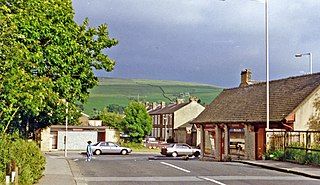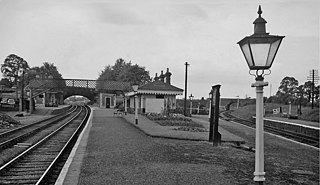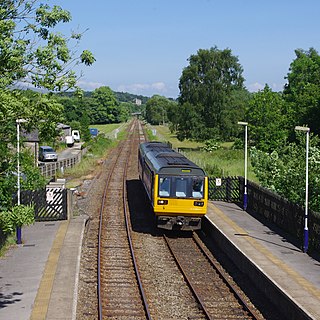
Barnoldswick is a market town and civil parish in the Borough of Pendle, in the administrative county of Lancashire, England. It is within the boundaries of the historic West Riding of Yorkshire. Barnoldswick and the surrounding areas of West Craven have been administered since 1974 as part of the modern administrative county of Lancashire. This was when West Riding County Council and Barnoldswick Urban District Council were abolished and the town was transferred to the Borough of Pendle.

Colne railway station serves the town of Colne, in Lancashire, England, which is situated close to Pendle Hill. The station, which is managed by Northern, is the eastern terminus of the East Lancashire Line. Trains from Blackpool South run through Preston and Blackburn to Burnley and Colne.

Skipton railway station is a Grade II listed station which serves the market town of Skipton in North Yorkshire, England on the Airedale Line, which gives Skipton access to destinations such as Leeds, Bradford, Carlisle, Lancaster and Morecambe. The station is operated by Northern Trains and is situated 27 miles (43 km) north-west of Leeds.
The Leeds and Bradford Railway Company (L&BR) opened a railway line between the towns on 1 July 1846. It extended its line from Shipley through Keighley to Skipton and Colne, in 1847 and 1848.
The Tenbury and Bewdley Railway was an English railway company that built its line from Bewdley in Worcestershire to Tenbury station, which was in Shropshire. The line connected the Severn Valley Railway at Bewdley with the Tenbury Railway at Tenbury. The Tenbury Railway connected at Woofferton with the Shrewsbury and Hereford Railway main line. Two railways were sometimes referred to as the Wyre Forest line or simply the Tenbury Line.
Longton Bridge was a railway station on the West Lancashire Railway in England. It served the village of Longton.

Barnoldswick railway station was the only railway station on the Midland Railway's 1-mile-64-chain (2.9 km) long Barnoldswick Branch in the West Riding of Yorkshire in England. It served the market town of Barnoldswick, which was in West Riding of Yorkshire at the time. The line left the Leeds and Bradford Extension Railway at Barnoldswick Junction 55 chains from Earby railway station. The line through the junction was on a 20-chain radius after which it converged to a single track and ran in a straight but undulating line to Barnoldswick. The passenger train that ran back and forth between Barnoldswick and Earby was known locally as the 'Barlick Spud' or 'Spudroaster'. The real reason for the name is lost in time, but the two versions that were commonly recited are that the original branch locomotive was so small it looked like a portable potato roaster used by a local vendor or that the journey time was the same as that taken to roast a potato in the locomotive's firebox.
Oldham Clegg Street railway station was the Oldham, Ashton-under-Lyne and Guide Bridge Junction Railway station that served the town of Oldham in northwest England, it had three associated goods stations.

Earby railway station was a junction station that served the town of Earby, in the West Riding of Yorkshire, England. Since 1974 Earby is within the boundaries of the administrative county of Lancashire. The station was built by the Midland Railway, on the former Leeds and Bradford Extension Railway between Skipton and Colne and opened in 1848.

Berkeley Road railway station served the towns of Berkeley and Dursley in Gloucestershire, England.

The Leeds and Bradford Extension Railway was an early British railway company in the West Riding of Yorkshire. It built a line from Shipley near Bradford through Keighley and Skipton to Colne. The Skipton–Colne Line closed in 1970, but the remainder of the line is still in use today, and once formed part of the Midland Railway's main line route from London to Glasgow.

Thongs Bridge railway station was the only intermediate stop on the railway line between Brockholes and Holmfirth, West Yorkshire, England. Opened in July 1850, the station was temporarily closed in 1865 due to the collapse of Mytholmbridge Viaduct. The station closed to passengers permanently in 1959, closing completely in 1965.

The Leeds–Morecambe line, also known as the Bentham line, is a railway line running between Leeds, Skipton, Lancaster and Morecambe in northern England. The service is operated by Northern. The route covered by the service was historically part of the Midland Railway. The line is electrified at 25 kV AC overhead between Leeds City and Skipton- this section is known as the Airedale line.
The Alcester–Bearley branch line was a 6+3⁄4-mile single-track branch railway line in Warwickshire, England. It was built by the Alcester Railway Company. It connected the manufacturing town of Alcester into the Great Western Railway network, opening in 1876.

Dyserth railway station served the village of Dyserth, Flintshire, Wales. It was the southern terminus of the 2 miles 70 chains (4.6 km) Dyserth branch, most of which is now a public footpath. At its peak Dyserth had passengers in the thousands. In 1930 the line and station closed for passengers in the face of road competition. At one point fourteen trains a day had shuttled along the line. Although the station has long been demolished, a crane from the station has been installed at the end of the walk as a feature of historical interest, as have two pieces of track at Chapel Street.

Westhead Halt railway station was on the Skelmersdale branch, which ran from Ormskirk to Rainford Junction via Skelmersdale. Most trains ran beyond Rainford Junction through to St Helens.
Blaenau Festiniog Junction railway station was the Festiniog Railway (FR)'s third of eventually five passenger stations in Blaenau Ffestiniog, then in Merionethshire, now in Gwynedd, Wales.

Thwaites railway station was a railway station located just east of Keighley, West Riding of Yorkshire, on the Midland Railway line through the Aire Valley between Keighley and Shipley. It opened to traffic in 1892 and closed 17 years later in 1909 due to poor patronage.

The Clayton West branch line was a standard gauge passenger and freight railway near Huddersfield, in West Yorkshire, England. The line was built by the Lancashire and Yorkshire Railway, opening to traffic in September 1879. Many proposals were considered to extending the line eastwards towards Darton, and then connecting to Barnsley, but these never came to fruition. In 1963, both stations on the line,, were listed for closure under the Beeching cuts, but the branch survived as a passenger carrying railway until 1983. The branch also forwarded coal from two collieries adjacent to the line, which maintained a freight service on the branch up until closure.













